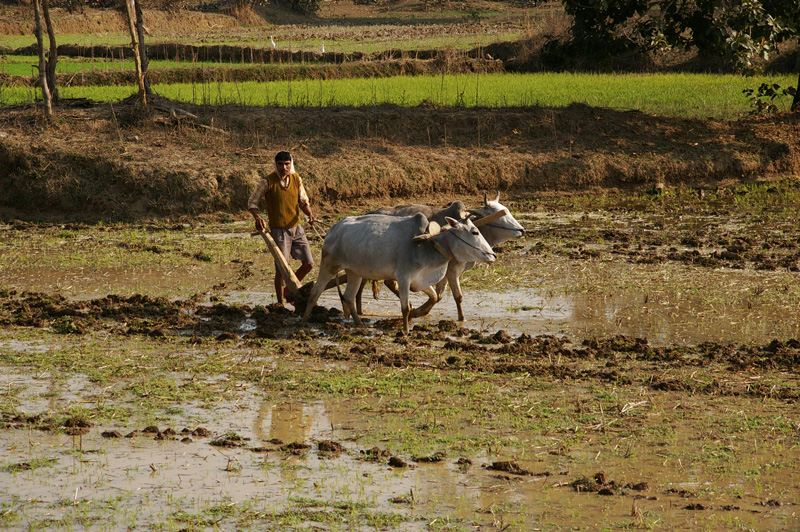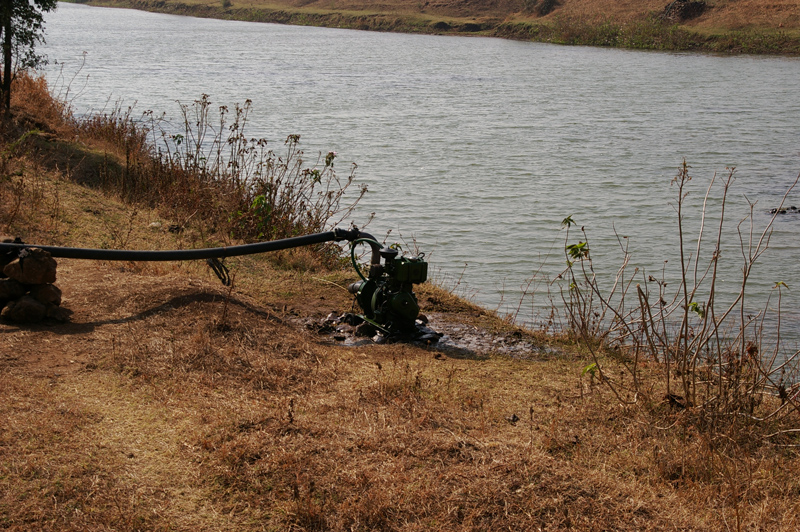


Indian agriculture
Photo courtesy of Pinki Mondal February 25, 2021
UD professor says groundwater depletion could reduce winter cropped acreage significantly in years ahead
India is the world's second-largest producer of wheat and rice and is home to more than 600 million farmers.
The country has achieved impressive food-production gains since the 1960s, due in part to an increased reliance on irrigation wells, which allowed Indian farmers to expand production into the mostly dry winter and summer seasons.
Those gains, however, have come at a cost: The country that produces 10 percent of the world's crops is now the world's largest consumer of groundwater, and aquifers are rapidly becoming depleted across much of India.
Indian government officials have suggested that switching from groundwater-depleting wells to irrigation canals, which divert surface water from lakes and rivers, is one way to overcome projected shortfalls.
But in a study published Feb. 24 in the journal Science Advances, a University of Michigan researcher and her colleagues, including Pinki Mondal from the University of Delaware, conclude that a switch to canal irrigation will not fully compensate for the expected loss of groundwater in Indian agriculture.

The authors estimate that if Indian farmers lose all access to groundwater in overexploited regions, and if that irrigation water is not replaced with water from other sources, then winter cropped acreage could be reduced by up to 20 percent nationwide. However, that scenario seems highly unlikely and was included in the study only as an upper-bound estimate.
It seems more likely that any future groundwater shortfalls would be at least partially offset by increases in canal irrigation. But even if all Indian regions currently using depleted groundwater switch to canal irrigation, winter cropped acreage could still decline by 7 percent nationwide and by 24 percent in the most severely affected locations.
"Our results highlight the critical importance of groundwater for Indian agriculture and rural livelihoods, and we were able to show that simply providing canal irrigation as a substitute irrigation source will likely not be enough to maintain current production levels in the face of groundwater depletion," said study lead author Meha Jain of the University of Michigan.
The study analyzed high-resolution satellite imagery and village-level census data and focused on winter cropped acreage.
Mondal, assistant professor in the Department of Geography and Spatial Sciences in UD’s College of Earth, Ocean and Environment, said it was important to look at the high-resolution data in this way because India is such a diverse agricultural country, it is hard to make a one-size fits all recommendation to solving the problem with regards to agriculture.
“We were very hesitant to say something in a sweepingly, homogenizing kind of way,” said Mondal. “When you bring in the place-based knowledge and the high-resolution data, it becomes more and more clear how complicated these systems are. We cannot, and we should not, use a broad-brush approach to everything. We cannot just generalize across the scale.”

Examples of this diversity, according to Mondal, are how central India is home to mostly semi-subsistence level farmers — farmers who use less mechanization to work their fields and depend largely on rainfall — whereas the more affluent parts of western India have larger, wealthier groundwater-dependent farming operations that are highly mechanized.
Mondal’s work early on in this project showed that while the farms may be different, they do have one similarity, all being somewhat limited with their access to water.
While nearly all Indian farmers plant crops during the monsoon to take advantage of seasonal rains, winter agriculture is mainly reliant on groundwater irrigation and now accounts for 44 percent of the country's annual cropped acreage for food grains.
"These findings suggest that other adaptation strategies, in addition to canal expansion, are needed to cope with ongoing groundwater losses," said Jain, an assistant professor at the U-M School for Environment and Sustainability.
The possibilities include switching from winter rice to less water-intensive cereals, increased adoption of sprinklers and drip irrigation to conserve water in the fields, and policies to increase the efficiency of irrigation canals.
While groundwater depletion is becoming a global threat to food security, and the extent of current and projected groundwater depletion are well documented, the potential impacts on food production remain poorly quantified.
The study by Jain and colleagues is the first to use high-resolution empirical data, including census data about the irrigation methods used in more than 500,000 Indian villages, to estimate the crop production losses that may occur when overexploited groundwater is lost.
The proliferation of deep (>100 feet) irrigation wells called tube wells since the 1960s has enabled Indian farmers to increase the number of seasons when crops are planted in a given year. This increase in "cropping intensity" is credited for much of the country's food-production gains.
Mondal said that farmers in India plant winter crops because there is not much room available for agriculture expansion in the country.
“Over half of the land area in India is pretty much taken in terms of agriculture. If we also want to protect the rich biodiversity in India, agricultural expansion does not appear to be a good option,” said Mondal. “What we can do is agriculture intensification, meaning that we can keep using the same land multiple times a year to produce food in an environmentally sustainable way.”
The researchers used satellite data to measure Indian winter cropped areas, a key determinant of cropping intensity. They then linked the satellite data to census information about the three main types of irrigation infrastructure in India: shallow "dug wells," deeper tube wells and canals that divert surface water.
Linking the two datasets allowed them to determine the relative efficacy of each irrigation method. That, in turn, enabled them to estimate potential future acreage losses and the ability of canal expansion to fill the gap.
The study's worst-case scenario found that winter cropped areas could decrease by up to 20 percent nationwide and by 68 percent in the most severely affected regions, if farmers lose all access to groundwater and if that irrigation water is not replaced from another source. The expected losses would largely occur in northwest and central India, according to the study.
The researchers also found that increased distance from existing irrigation canals is strongly associated with decreased acreage planted with winter crops. In the future, a greater reliance on canals could increase inequity related to irrigation access, according to the authors.
“Even if you shift the reliance to canal irrigation as has been suggested at some government levels, we still see a significant winter crop loss,” said Mondal. “Our data show that canal irrigation would not be able to recover all the crop losses that we would see from losing the groundwater that we have.”
In addition, the lakes and rivers that feed irrigation canals rise and fall in response to rainfall variability, unlike deep groundwater wells. So, a greater reliance on canal irrigation in the future would result in increased sensitivity to year-to-year precipitation fluctuations, as well as any long-term trends due to human-caused climate change.
The authors of the Science Advances study, in addition to Jain and Mondal, are Ram Fishman of Tel Aviv University; Gillian Galford of the University of Vermont; Nishan Bhattarai of the U-M School for Environment and Sustainability; Shahid Naeem, Upmanu Lall and Ruth DeFries of Columbia University; and Balwinder Singh of the International Maize and Wheat Improvement Center in New Delhi.
The work was funded by a NASA New Investigator Award to Jain and two NASA Land Cover and Land Use Change grants, one awarded to DeFries and one to Jain.
Contact Us
Have a UDaily story idea?
Contact us at ocm@udel.edu
Members of the press
Contact us at 302-831-NEWS or visit the Media Relations website

